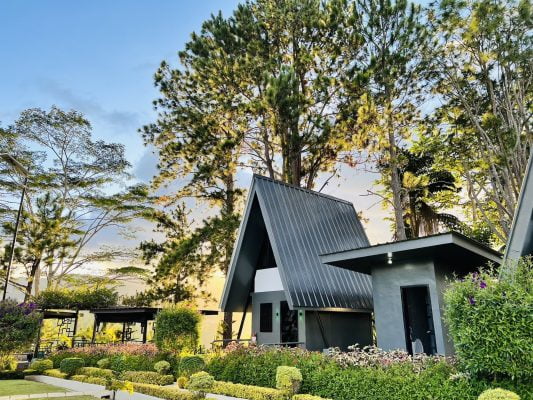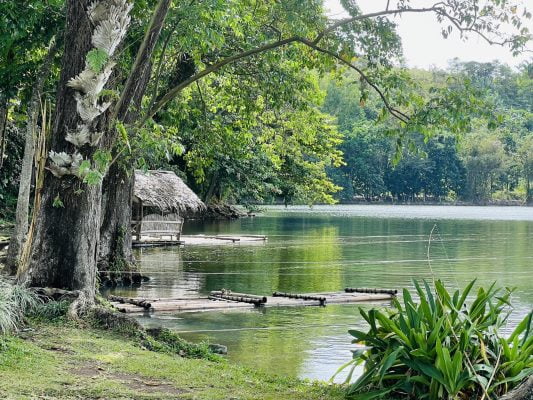
Growing up in Davao City means you take at least two field trips to the Philippine Eagle Center during your years in primary school. I made at least five trips. It’s an unspoken requisite for students to learn about and appreciate the intricacy of the local ecosystem, no matter how mind-boggling it was to us then. I might not have appreciated it before, but I do now.
It was a beautiful day when we drove south; the skies were clear and the sun seemed not too eager to burn our skin. The Philippine Eagle Center is located in Malagos, Calinan, close to the foothills of Mt. Talomo and Mt. Apo. It’s a 45-minute drive from the city, commuting might take longer and cost more, depending on what type of public transport you take.

Home to the Philippine Monkey-Eating Eagle
The Philippine Eagle Center is the country’s leader in saving local species of raptors, particularly the national bird, the Philippine Eagle aka Monkey-Eating Eagle (Pithecophaga jefferyi) and its natural habitat. It is both a conservation center and a major tourist attraction in Davao City.


Entering the complex, visitors see souvenir shops selling batik fabrics, woven bags, malong, and other native products. At the gate, the Davao City Water District collects very small entrance fees: P5 for adults and P3 for kids. Entrance fees to the Philippine Eagle Center are P50 for adults and P30 for youth (18 years old and younger). Guided tours are available but most visitors just follow a paved concrete trail that winds through the rainforest setting, passing by aviaries and cages containing the different fauna sheltered in the center.
Home to Endemic Flora and Fauna
Philippine Eagle Center’s attractions are not only the birds and animals; it is also the lush foliage of different plant species all over the area. Visitors should look around and look beyond the fascinating eagles and owls. I did so and noticed some very intriguing shrubs, flowers, and fruit-bearing trees. The trail features concrete blocks “signed” by visitors since it opened in 1988.

Along the trail is an estuarine crocodile which has been there for as far as I can remember, some Grass Owls, Brahminy Kites, Philippine Serpent Eagles (endemic specie), Gray Headed Fishing Eagles, Pinkser’s Hawk Eagles (endemic specie), White-bellied Sea Eagles, the Philippine Brown Deer (endemic specie), the Philippine Warty Pig (endemic specie), some macaques, and of course some Philippine Monkey-Eating Eagles.
The King of Birds
Pag-asa, the first Philippine Eagle bred and hatched in captivity still lives in the center and just turned 22 years old last January 15, 2014. The male eagle is the offspring of Diola and Junior. Pag-asa has sired his very first offspring with female eagle Kalinawan in January 9, 2013. The eaglet named Mabuhay is now a year old. He represents the second generation of Philippine Eagles bred in captivity in the center. Pag-asa will hopefully live up to 40 years old in captivity. Those who roam free in the wild barely reach adulthood due to environmental degradation and human cruelty.


Philippine Eagles practice life-long monogamy and the male and female share the responsibility of taking care of their young. They mate from July to February and the female only lays a single egg every two years. In rainforests, nests are made in the highest branches on old-growth trees. During the mating season, the male woes his partner by providing her with food and materials to build their nest. In captivity, human surrogate mate partners participate in the process to ensure successful breeding.
There are other Philippine Eagles on display in separate aviaries/cages in the center, all bred and hatched in captivity: Sambisig (female), Maginoo (male), Dakila (female), Kaibigan (female) and Scout Binay (male). Scout Binay is not confined in a cage; instead, he is placed on a pedestal where visitors can interact with him and view him up close. He may be the luckiest of them all; I can only guess that having to live in a cage for a lifetime is not really exciting. But then again, they’re better off in cages than in the wild where they fear for their lives every second.

Conservation Efforts
The Philippine Eagle Center has released a good number of Philippine Eagles into the wild and almost always, they end up dead a few weeks/months after. These raptors may seem all too powerful for smaller animals in the rainforests of Mindanao and other parts of the Philippines but they are no match to guns, chainsaws, and other elements that constantly destroy their natural habitat. Thus, the DENR declared the Philippine Eagle a critically endangered species, only about 180-500 of them survive. Jail time and heavy fines await anyone who kills a Philippine Eagle.
Our hour-long tour ended and we learned a lot along the trail. I noticed that there were plenty of young volunteers sweeping fallen leaves and pointing guests in the right direction. Young scouts (Pathfinders, I think) also assembled on the grounds. I can only assume that they were there to learn about the ecosystem, just like I did some years ago. It is heart-warming to know that the youth are finally taking responsibility for the environment. After all, the world is theirs to govern and save in the near future.

Here are some more photos:





If you want to know more about the Philippine Eagle and the Philippine Eagle Center, you may visit their website. For guided tours, please call ahead to make sure there are available guides.






